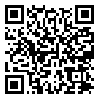Fri, Sep 19, 2025
[Archive]
Volume 13, Issue 2 (5-2023)
J Adv Biomed Sci. 2023, 13(2): 131-137 |
Back to browse issues page
Download citation:
BibTeX | RIS | EndNote | Medlars | ProCite | Reference Manager | RefWorks
Send citation to:



BibTeX | RIS | EndNote | Medlars | ProCite | Reference Manager | RefWorks
Send citation to:
Aliasgharpour M. Graphite Furnace Atomic Absorption Spectrometry for Biomonitoring of Blood Lead Level in Quality Control Blood Materials. J Adv Biomed Sci. 2023; 13 (2) :131-137
URL: http://jabs.fums.ac.ir/article-1-2944-en.html
URL: http://jabs.fums.ac.ir/article-1-2944-en.html
Reference Health Laboratory, Ministry of Health & Medical Education, Tehran, Iran , mehri9@gmail.com
Abstract: (1807 Views)
Background & Objective: Lead (Pb) is a major toxicant that has threatened human health for years. There is no safe level of exposure and deposition of a small amount of Pb in the human body has a negative impact on an individual's health. Despite recent reductions in its use, it has caused extensive environmental contamination as well. In the present study, the intralaboratory quality control assessment is reported as an initial step in lead determination by Graphite furnace atomic absorption spectrometry (GFAAS).
Materials & Methods: Varian SpectrAA-220 with partition tube and deuterium background correction was used for the analysis. The evaluation quality control blood material was Seronorm trace elements whole blood (levels I &II).
Results: The lowest method limit of detection was 0.74 μg/dL, and based on the regression analysis, the lowest quantification concentration was 3.00 μg/dL (CV = 4.6 %). In addition, obtained %CV for Seronorm (I) & Seronorm (II) was 7.3% & 5.4% respectively.
Conclusion: In recent years, several diverse technological advancements in blood lead level determination have occurred. At the same time, demands for blood lead (BPb) level determination by GFAAS has been increased by public health in order to identify children exposed to lead in the environment, and by occupational health to reduce excessive exposure in the lead industries. The obtained results indicated that for BPb analysis, the method described by GFAAS is still a reference routine analytical technique that requires less time and no matrix matched standard curve, allowing blood samples to be run against aqueous calibration standards which eliminates the need for standard additions.
Materials & Methods: Varian SpectrAA-220 with partition tube and deuterium background correction was used for the analysis. The evaluation quality control blood material was Seronorm trace elements whole blood (levels I &II).
Results: The lowest method limit of detection was 0.74 μg/dL, and based on the regression analysis, the lowest quantification concentration was 3.00 μg/dL (CV = 4.6 %). In addition, obtained %CV for Seronorm (I) & Seronorm (II) was 7.3% & 5.4% respectively.
Conclusion: In recent years, several diverse technological advancements in blood lead level determination have occurred. At the same time, demands for blood lead (BPb) level determination by GFAAS has been increased by public health in order to identify children exposed to lead in the environment, and by occupational health to reduce excessive exposure in the lead industries. The obtained results indicated that for BPb analysis, the method described by GFAAS is still a reference routine analytical technique that requires less time and no matrix matched standard curve, allowing blood samples to be run against aqueous calibration standards which eliminates the need for standard additions.
Keywords: Lead Exposure- Graphite Furnace Atomic Absorption- Biomonitoring- Precision-Intralaboratory
Type of Study: Research |
Subject:
Biochemistry
Received: 2023/02/1 | Accepted: 2023/05/9 | Published: 2023/07/1
Received: 2023/02/1 | Accepted: 2023/05/9 | Published: 2023/07/1
Send email to the article author
| Rights and permissions | |
 |
This work is licensed under a Creative Commons Attribution-NonCommercial 4.0 International License. |

This work is licensed under a Creative Commons — Attribution-NonCommercial 4.0 International (CC BY-NC 4.0)







